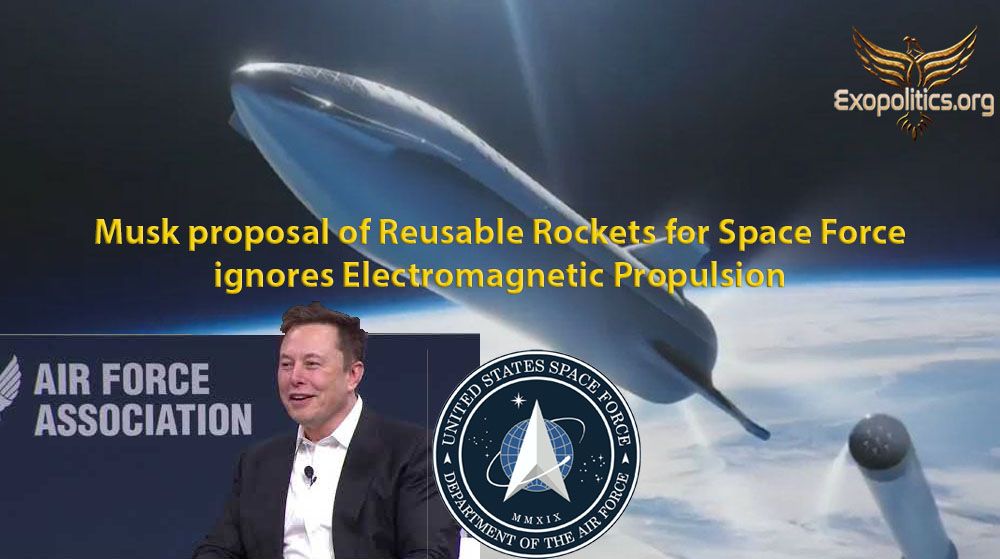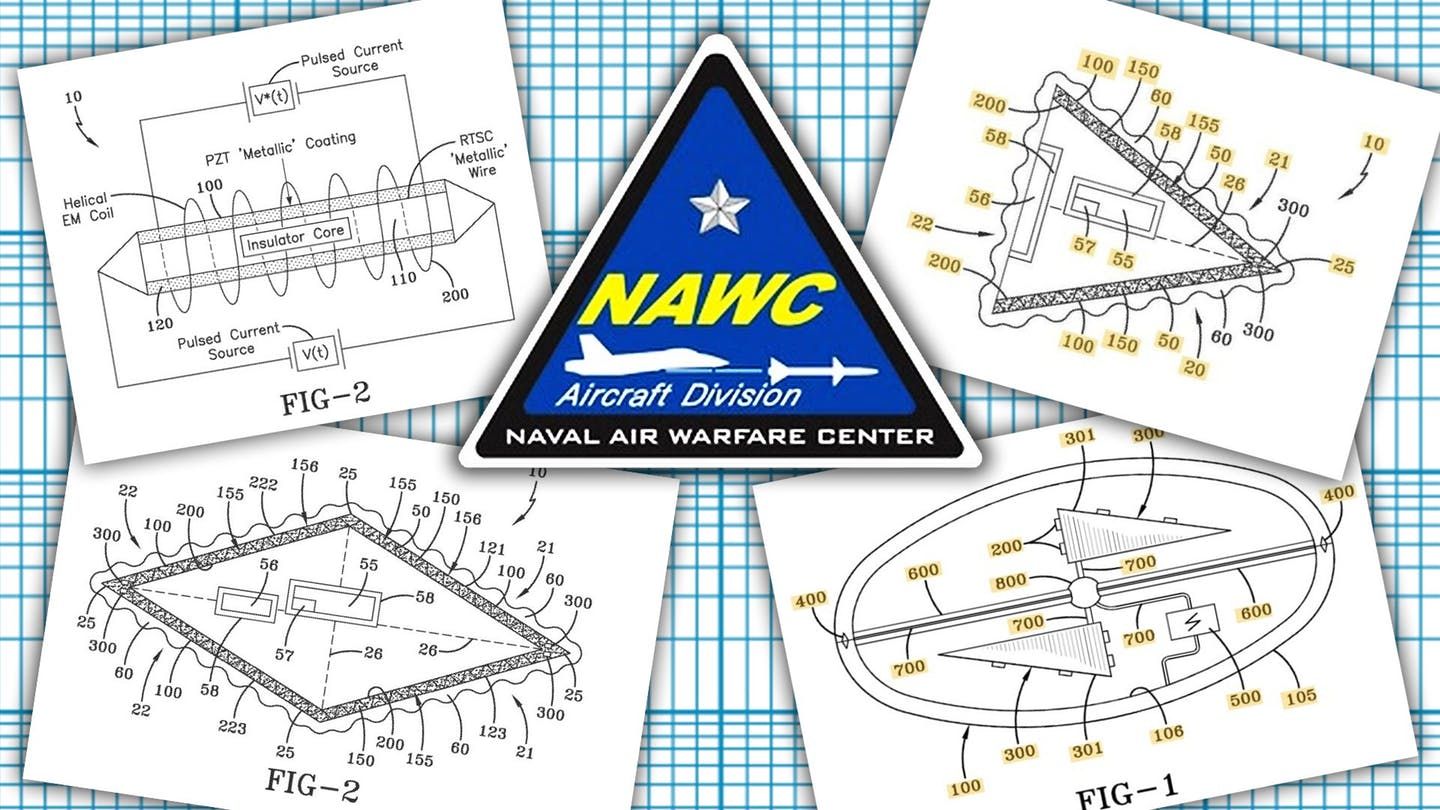Musk proposal of Reusable Rockets for Space Force ignores Electromagnetic Propulsion
On February 27, at the US Air Force Association’s “Air Warfare Symposium”, Space X founder Elon Musk posed the question, “How do we make Starfleet real?” and he proposed reusable rockets as “absolutely fundamental” for the newly created Space Force.
Musk’s aggressive lobbying of reusable rocket propulsion technologies for future space exploration ignores increasing evidence that electromagnetic propulsion systems are not only scientifically feasible, but have been developed for classified spacecraft, many of which have been predicted to be soon transferred to Space Force.
Musk has undoubtedly shaken the conventional space industry with his pioneering work in developing reusable Falcon rockets for launching Dragon spacecraft that are used to deploy satellites and ferry supplies to the International Space Station. Many were thrilled to watch videos of the Falcon rockets safely returning either on land or on ocean-going barges, after some spectacular early failures.
The reusable Falcon rocket landings were followed later by Dragon spacecraft descending to Earth by first deploying parachutes to slow their descent through the atmosphere before performing an ocean splashdown. The manned version called Dragon 2 is designed to carry up to seven crew and will also perform a splashdown after completing its space mission. This effectively duplicates the Apollo era process for the return of manned space capsules.
Currently, Musk is developing a reusable Starship which again relies on rocket propulsion to take astronauts to the Moon and Mars. Measuring 160 feet (50 meters) in length, the Starship is significantly larger than the Dragon 2 and will sit atop a super heavy Falcon launch rocket. The Starship is designed to carry sufficient rocket fuel to make it possible to maneuver in space, land on the Moon, and return safely back to Earth.
At a February 28 test, a prototype Starship collapsed at the SpaceX facility in Boca Chia, Texas, showing similar development challenges to that previously faced with the Falcon rockets. Musk is confident that Space X will overcome these developmental problems and come up with a reusable spacecraft with similar capabilities to the abandoned Space Shuttle.
There is little doubt that the idea of reusable rockets is currently very helpful in transforming the space industry and moving things in the direction of multi-use space launch vehicles that will be much cheaper, reliable and safer. This has been predicted to kickstart a civilian space industry making it possible for space tourism to take off later this decade.
Musk’s ambitious plans to use reusable rockets for manned flights to service the International Space Station, trips to the Moon, and eventually establishing colonies on Mars does indeed raise important questions for the newly created Space Force. Are reusable rockets “absolutely fundamental” to Space Force as Musk contends?
There is little question, when one reviews the available evidence and whistleblower/insider testimonies that the US Air Force, like the Navy, has for decades been developing electromagnetic propulsion systems in multiple highly classified programs. I have presented the best available evidence in successive books on the secret space programs developed by the US Navy and USAF.
Very recently, the Navy has had one of its most innovative scientists, Dr. Salvator Pais, apply for patents showing the feasibility of an electromagnetically propelled hybrid spacecraft capable of traveling underwater, in the air and space. After the patent examiner rejected the application for the “Hybrid Aerospace Underwater Craft” as not scientifically feasible since it lacked an adequate power supply, the Navy intervened by having another scientist write a letter in support of Pais.
Dr. James Sheehy, the Chief Technology Officer for the Naval Aviation Enterprise pointed out that Pais’ patent application was scientifically feasible and was being experimented on. In his letter, Dr. Sheehy wrote about the electromagnetic propulsion systems making rocket engines obsolete:
If successful the realization of this result demonstrates that this patent documents the future state of the possible and moves propulsion technology beyond gas dynamic systems to field-induced propulsion based hybrid aerospace-undersea craft…

Importantly, Sheehy went on in his letter to point out that China was working on similar electromagnetic propulsion systems. Not granting the patent would lead to China gaining the intellectual property rights on such innovative technology, which had been originally conceived in the US, and very likely acquired by China through industrial espionage.
Sheehy’s warning was correct, China has indeed acquired classified US aerospace technologies and is in the midst of a rapid development process for fleets of electromagnetically propelled vehicles that are part of a secret space program that is far more powerful than its public space program using rocket propulsion systems.
China aims to overtake the US as a leading space power by 2030 through advances in Artificial Intelligence and deployment of 5G systems that are at the core of its asymmetric military strategy dubbed “Assassin’s Mace”. In my new book, Rise of the Red Dragon: Origins and Threat of China’s Secret Space Program, the full extent of China’s technological advances and how it plans to use AI and 5G to achieve space dominance are laid out in detail.
Recently, a number of former servicemen from the USAF and Navy have come forward with their testimonies that the Tic Tac UFOs captured on infrared video by Navy pilots, had an important USAF connection. One of them, Mike Turber, says that he was told by a reliable source that the Tic Tac craft belonged to the USAF and had been built at its secretive Plant 42 facility in Palmdale, California, by leading aerospace contractors.
Given the abundant evidence that the USAF and Navy have secretly developed electromagnetic propulsion systems, why would the newly created Space Force be interested in Musk’s reusable rocket propulsion systems?
Sure, reusable rockets are superior to the expensive single-use rocket launch vehicles that have been dominant since the 2011 retirement of the Space Shuttle. However, both single-use and reusable rocket systems are dramatically inferior to electromagnetically propelled spacecraft capable of traveling at speeds that defy conventional physics, as spectacularly demonstrated by the Tic Tac UFO craft.
Musk made his comments in a fireside chat with Lieutenant General John Thomson, Commander of the USAF Space and Missiles Systems Center, Los Angeles Air Force Base, which was only a few months ago transferred over to Space Force. Was General Thomson genuinely interested in reusable rockets for Space Force or did he have another agenda in mind?
There are three possibilities that come to mind that help explain why General Thompson and Space Force may be interested in hearing Musk’s views about reusable rocket propulsion systems.
First, reusable rockets are a useful stepping-stone to the far more effective and powerful electromagnetic propulsion technologies that Space Force is in the process of receiving from the US Air Force’s secret space program, as I have discussed elsewhere. I find this possibility highly unlikely given the unnecessary expense of building reusable rocket technologies that Space Force leaders would deem vastly inferior to electromagnetically propelled spacecraft.
A second possibility is that Musk’s advocacy of reusable rockets might be a convenient smokescreen for Space Force deploying electromagnetically propelled spacecraft, without revealing the true propulsion system being used until the right time. Put simply, there may be a need for Space Force leaders to hide from the public the true origins and development history of its reusable spacecraft.
A third possibility is that General Thompson and Space Force intends to partner with Musk since he has shown with his innovative Tesla electric car company a sustained interest in moving the car industry away from fossil fuels to electrical energy. Musk can therefore in the future play a leading role in moving the space industry away from rockets towards electromagnetic propulsion systems.
Therefore, in responding to Musk’s question, “How do we make Starfleet real?”, the answer is definitely not through reusable rockets as proposed by Musk. However, reusable rockets may be a convenient stepping stone or smokescreen for electromagnetic propulsion systems that Space Force will be deploying in the near future. Indeed, Musk may ultimately prove to be a pivotal figure in helping introduce electromagnetic propulsion systems to the general public as he learns about the classified technologies Space Force plans to release to the public.
© Michael E. Salla, Ph.D. Copyright Notice
Further Reading
- Evidence Grows that Tic Tac UFOs are Secret Air Force Spacecraft
- Tic Tac UFOs belong to USAF secret space program says Intelligence Specialist
- Trump signs Space Force Act – Stage Set for Secret Space Program Disclosure
- USAF Secretary & Congressman want to Declassify Secret Space Programs
- Space Force is a Go as Congress Gives its Approval
- US Navy Disclosing Secret Space Program Technologies through Patents System








